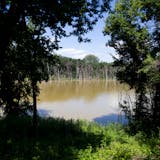CAMBRIDGE, MINN. – On the banks of the Rum River, Hailie Woodard stroked a canoe paddle in the water for the first time in her 16 years. Stepping carefully out of the wobbly boat, she sank into ankle-deep mud as she tried to fling clumps of wet wild rice seed on the water's edges.
It was true immersion learning.
Woodard, a lifelong city dweller who is part American Indian, had never seen the stalks of wild rice that were once so integral to indigenous life. But on a sun-kissed autumn day this week, she stood in mud and water to see and understand its environmental requirements and cultural significance. As part of a school field trip, she was helping to restore the aquatic plant to an area where it was once ubiquitous — and, trip leaders hoped, feel a connection to her indigenous heritage.
"It's good to know what you are," she said. "If you don't know what you are, you're just lost."
Woodard and eight of her classmates from the Takoda Prep alternative high school in Minneapolis helped spread wild rice to the main channel and backwaters of the river this week as two nonprofits, Wilderness Inquiry and Great River Greening, teamed up for the first time and brought urban students with them.
The Rum River, winding from Mille Lacs to the mighty Mississippi, was once a wild rice haven, contributing an important source of food for people and wildlife. While it still exists there naturally, it has declined in recent years. With a Legacy Amendment grant, Great River Greening, which aims to restore Minnesota's natural heritage, is helping to coax it to flourish with annual reseeding in the fall, hoping it will grow in the spring.
The grain is an important piece of Minnesota's environmental and cultural heritage.
An Ojibwe migration story tells of a cultural and spiritual tie to natural wild rice. Tribal prophets foretold that migration from the east would continue until people found food that grows on water. Known in Ojibwe as manoomin, wild rice is still revered in the culture.



